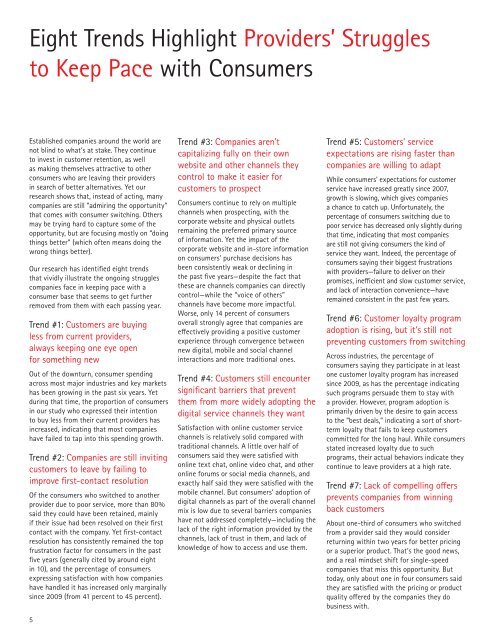Accenture-Customer-2020-Future-Ready-Reliving-Past
Accenture-Customer-2020-Future-Ready-Reliving-Past
Accenture-Customer-2020-Future-Ready-Reliving-Past
Create successful ePaper yourself
Turn your PDF publications into a flip-book with our unique Google optimized e-Paper software.
Eight Trends Highlight Providers’ Struggles<br />
to Keep Pace with Consumers<br />
Established companies around the world are<br />
not blind to what’s at stake. They continue<br />
to invest in customer retention, as well<br />
as making themselves attractive to other<br />
consumers who are leaving their providers<br />
in search of better alternatives. Yet our<br />
research shows that, instead of acting, many<br />
companies are still “admiring the opportunity”<br />
that comes with consumer switching. Others<br />
may be trying hard to capture some of the<br />
opportunity, but are focusing mostly on “doing<br />
things better” (which often means doing the<br />
wrong things better).<br />
Our research has identified eight trends<br />
that vividly illustrate the ongoing struggles<br />
companies face in keeping pace with a<br />
consumer base that seems to get further<br />
removed from them with each passing year.<br />
Trend #1: <strong>Customer</strong>s are buying<br />
less from current providers,<br />
always keeping one eye open<br />
for something new<br />
Out of the downturn, consumer spending<br />
across most major industries and key markets<br />
has been growing in the past six years. Yet<br />
during that time, the proportion of consumers<br />
in our study who expressed their intention<br />
to buy less from their current providers has<br />
increased, indicating that most companies<br />
have failed to tap into this spending growth.<br />
Trend #2: Companies are still inviting<br />
customers to leave by failing to<br />
improve first-contact resolution<br />
Of the consumers who switched to another<br />
provider due to poor service, more than 80%<br />
said they could have been retained, mainly<br />
if their issue had been resolved on their first<br />
contact with the company. Yet first-contact<br />
resolution has consistently remained the top<br />
frustration factor for consumers in the past<br />
five years (generally cited by around eight<br />
in 10), and the percentage of consumers<br />
expressing satisfaction with how companies<br />
have handled it has increased only marginally<br />
since 2009 (from 41 percent to 45 percent).<br />
5<br />
Trend #3: Companies aren’t<br />
capitalizing fully on their own<br />
website and other channels they<br />
control to make it easier for<br />
customers to prospect<br />
Consumers continue to rely on multiple<br />
channels when prospecting, with the<br />
corporate website and physical outlets<br />
remaining the preferred primary source<br />
of information. Yet the impact of the<br />
corporate website and in-store information<br />
on consumers’ purchase decisions has<br />
been consistently weak or declining in<br />
the past five years—despite the fact that<br />
these are channels companies can directly<br />
control—while the “voice of others”<br />
channels have become more impactful.<br />
Worse, only 14 percent of consumers<br />
overall strongly agree that companies are<br />
effectively providing a positive customer<br />
experience through convergence between<br />
new digital, mobile and social channel<br />
interactions and more traditional ones.<br />
Trend #4: <strong>Customer</strong>s still encounter<br />
significant barriers that prevent<br />
them from more widely adopting the<br />
digital service channels they want<br />
Satisfaction with online customer service<br />
channels is relatively solid compared with<br />
traditional channels. A little over half of<br />
consumers said they were satisfied with<br />
online text chat, online video chat, and other<br />
online forums or social media channels, and<br />
exactly half said they were satisfied with the<br />
mobile channel. But consumers’ adoption of<br />
digital channels as part of the overall channel<br />
mix is low due to several barriers companies<br />
have not addressed completely—including the<br />
lack of the right information provided by the<br />
channels, lack of trust in them, and lack of<br />
knowledge of how to access and use them.<br />
Trend #5: <strong>Customer</strong>s’ service<br />
expectations are rising faster than<br />
companies are willing to adapt<br />
While consumers’ expectations for customer<br />
service have increased greatly since 2007,<br />
growth is slowing, which gives companies<br />
a chance to catch up. Unfortunately, the<br />
percentage of consumers switching due to<br />
poor service has decreased only slightly during<br />
that time, indicating that most companies<br />
are still not giving consumers the kind of<br />
service they want. Indeed, the percentage of<br />
consumers saying their biggest frustrations<br />
with providers—failure to deliver on their<br />
promises, inefficient and slow customer service,<br />
and lack of interaction convenience—have<br />
remained consistent in the past few years.<br />
Trend #6: <strong>Customer</strong> loyalty program<br />
adoption is rising, but it’s still not<br />
preventing customers from switching<br />
Across industries, the percentage of<br />
consumers saying they participate in at least<br />
one customer loyalty program has increased<br />
since 2009, as has the percentage indicating<br />
such programs persuade them to stay with<br />
a provider. However, program adoption is<br />
primarily driven by the desire to gain access<br />
to the “best deals,” indicating a sort of shortterm<br />
loyalty that fails to keep customers<br />
committed for the long haul. While consumers<br />
stated increased loyalty due to such<br />
programs, their actual behaviors indicate they<br />
continue to leave providers at a high rate.<br />
Trend #7: Lack of compelling offers<br />
prevents companies from winning<br />
back customers<br />
About one-third of consumers who switched<br />
from a provider said they would consider<br />
returning within two years for better pricing<br />
or a superior product. That’s the good news,<br />
and a real mindset shift for single-speed<br />
companies that miss this opportunity. But<br />
today, only about one in four consumers said<br />
they are satisfied with the pricing or product<br />
quality offered by the companies they do<br />
business with.



